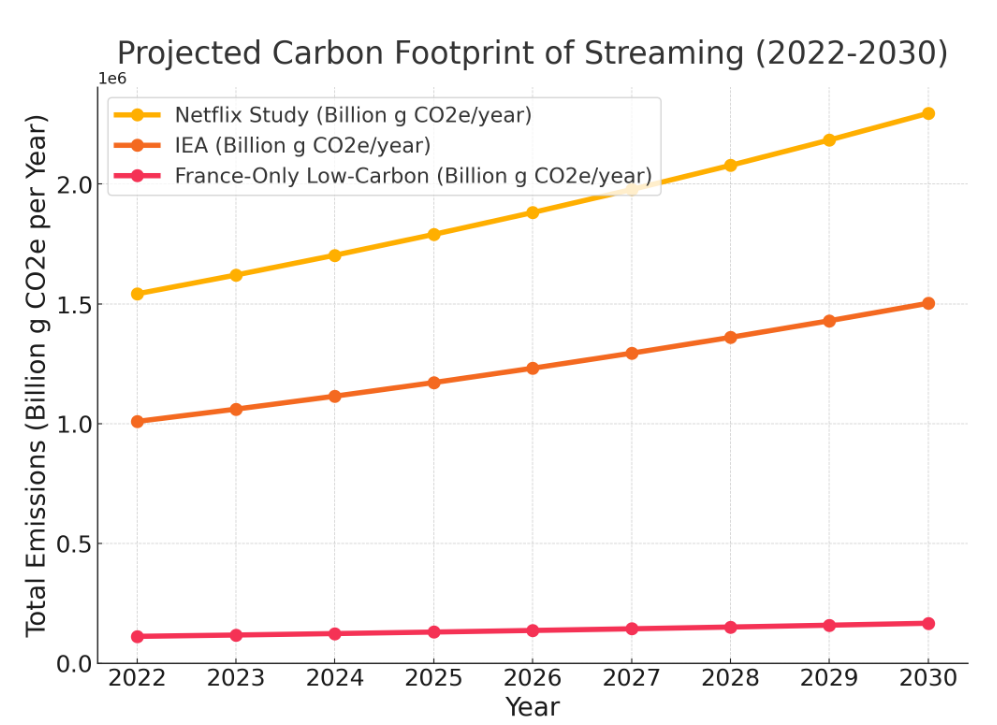Streaming the future of sustainability
Status:: 🟩
Links:: Climate emissions of videostreaming
Metadata
Authors:: Lewis, Ryan Hardesty; Conway, Alex
Title:: Streaming the future of sustainability
Date:: 2024
URL::
DOI::
Lewis, R.H. and Conway, A. (2024) ‘Streaming the future of sustainability’, in. HotCarbon 2024.
The rapid growth of digital video traffic presents both challenges and opportunities for sustainable content delivery. We argue that the shift towards on-demand streaming, exemplified by services like Netflix, provides a path to significantly reduce the carbon footprint and e-waste associated with traditional computing paradigms. By eliminating the need for local operating systems, enabling more efficient edge devices, and leveraging renewable-powered cloud infrastructure, streaming on-demand hardware and content can drive down energy use and embodied emissions. We analyze the key factors behind streaming’s improved sustainability and chart a course for further optimization, envisioning a future where streaming is the default across all computing domains. This future will be enabled by a new class of streamingoptimized edge devices and continued innovation in areas like video coding, adaptive bitrate algorithms, and energyefficient processing.
Notes & Annotations
Color-coded highlighting system used for annotations
📑 Annotations (imported on 2024-07-18#15:58:59)
Traditionally, studies have focused on the operational emissions of data centers, i.e., the emissions from powering the servers [6, 51]. However, this ignores the significant embodied emissions from manufacturing and transporting hardware, which can account for up to 50% of a data center’s total carbon footprint [21]. We note, however, that the embodied carbon footprint of millions of deployed devices like smartphones, watches, and laptops far outweighs any cloud provider’s current embodied carbon [18]. As cloud providers increasingly invest in renewable energy [49], the fraction of emissions coming from embodied sources in data centers is likely to grow.
With an advent of streaming remote hardware, like cloud gaming [8] and soon other intensive tasks such as remote desktops, we argue that this shift to streaming as the default video and computing method can significantly improve sustainability, by: (1) Reducing e-waste and embodied emissions from physical media and associated playback devices (2) Enabling edge devices optimized for energy-efficient video playback rather than general compute or storage (3) Centralizing processing and distribution in cloud data centers powered by renewable energy

Table 1: Estimated carbon intensity of one hour of streaming.
Finally, placing servers near renewable generation opens the possibility of exploiting stranded power - energy that would otherwise be curtailed when supply exceeds transmission capacity or local demand [20]. Large tech companies are beginning to explore data centers as flexible load to absorb such power [13].
There are varying estimates of the carbon footprint of streaming video, as shown in Table 1. 2019 estimates from The Shift Project [48] put the emissions at 394 g CO2e per viewing hour, a correction to a prior study in which they had mistakenly claimed streaming video was equivalent to driving over 10 km [26]. However, the Shift Project’s estimates are not considered reliable [26], with even a recent study sponsored by Netflix [45] estimating a footprint of just 55 g CO2e, 1/8th as much. The primary factors driving this low footprint are the technology trends described above - more efficient video codecs, the shift to cloud encoding from edge decoding, and the rapid adoption of renewable energy by cloud operators. The Netflix study finds that user devices still account for a large fraction (>50%) of overall energy usage in the streaming ecosystem. This suggests that major improvements are still possible, especially in reducing the environmental impact of devices. But even Netflix’s footprint can be further reduced through the streaming optimized devices described earlier, as the International Energy Agency (IEA) finds that 55 g CO2e/hr is still far too high and a more realistic number is 36 g CO2e/hr, which they compare as similar to boiling a kettle at 35 g CO2/hr [26]. The IEA goes on to show that if streaming is done in countries where energy is low-carbon, such as France, then the carbon footprint is only 4g CO2e/hr, a figure that serves to show the potential future benefits worldwide of streaming from carbon-free energy in data centers and using low-carbon streaming devices.
Our projections in Fig. 2 suggest a significant growth in the carbon footprint of streaming due to increased usage and improved streaming quality (e.g., higher resolutions). However, it is crucial to acknowledge that these projections are based on the assumption that streaming technology remains constant and that we will simply stream more. This assumption has been challenged in several prior works in ICT, which indicate that energy use does not scale linearly with data volume and that technological advancements often lead to greater energy efficiency [29, 31]. For example, Mytton et al. (2024) show that network energy use is not directly proportional to data volume, suggesting that future improvements in streaming efficiency could mitigate some of the projected increases in carbon footprint.

Figure 2: Projected carbon footprint of streaming video under current technological assumptions.